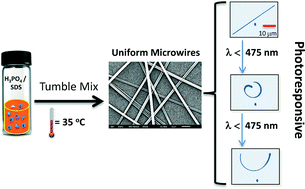Some crystals can deform on exposure to UV or visible light as a photoreaction proceeds during which the reactant and product are both present. This causes internal strain, which can result in crystals bending, jumping or twisting. For a well-defined response to occur, control of crystal size and shape are vital. Micron-sized crystals (microcrystals) are more likely to exhibit the desired behaviour, as larger crystals may shatter owing to the internal stresses produced.
A new paper outlines a method for producing uniform microcrystals. This is demonstrated by the synthesis of (E)-3-(anthracen-9-yl)acrylic acid (9-AYAA) from its t-butyl ester analogue by tumble mixing with phosphoric acid and a surfactant (sodium dodecyl sulfate, SDS). The size and shape can be controlled by the reaction temperature, concentration of phosphoric acid and SDS, the ester concentration and the mixing method. The optimised reaction conditions produce uniform 9-AYAA microwires, which undergo coiling (during the photoreaction) and uncoiling (as the reaction reaches completion) on exposure to 475 nm light, as shown in the figure below.
The new method involves an in-situ chemical reaction (acid hydrolysis) followed by re-precipitation and can also be successfully used to produce 9-AA (9-anthraldehyde) microplates under similar conditions. The authors attribute the success of their syntheses to the slow growth of the products and conclude the strategy could be used to produce microcrystals of uniform size and shape in other systems.
For more details, see the full paper at:
Chemical reaction method for growing photomechanical organic microcrystals
Rabih O. Al-Kaysi, Lingyan Zhu, Maram Al-Haidar, Muhannah K. Al-Muhannah, Kheireddine El-Boubbou, Tarafah M. Hamdan and Christopher J. Bardeen
CrystEngComm, 2015, DOI: 10.1039/C4CE02387K
 |
Gwenda Kyd has a PhD in metallocarborane chemistry from the University of Edinburgh. Other research work includes the spectroscopic study of the structure of glasses and organometallic electron-transfer reactions and the preparation of new inorganic phosphors. She has recently published a book on chemicals from plants. |











